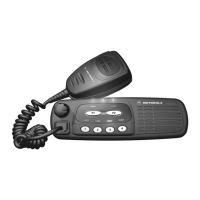Chapter 3: 1-1
6881091C63-A
Section 1
THEORY OF OPERATION
1.0 Controller Circuits
1.1 Overview
This section provides a detailed theory of operation for the radio and its components. The main radio
is a single-board design, consisting of the transmitter, receiver, and controller circuits. The main
board is designed to accept one option board. The option board may provide functions such as
secure voice/data, voice storage, or signaling decoder.
A control head is either mounted directly or connected by an extension cable. The control head
contains LED indicators, a microphone connector, buttons, and—depending on the radio type—a
display and a speaker. These provide the user with interface control over the various features of the
radio.
If no control head is mounted directly on the front of the radio, an expansion board containing
circuitry for special applications can be mounted on the front of the radio. An additional control head
can be connected by an extension cable.
In addition to the power cable and antenna cable, an accessory cable can be attached to a
connector on the rear of the radio. The accessory cable enables you to connect accessories to the
radio, such as an external speaker, emergency switch, foot-operated PTT, and ignition sensing, etc.
1.2 General
The radio controller consists of three main subsections:
• digital control
• audio processing
• voltage regulation
The digital control section of the radio is based upon an open architecture controller configuration. It
consists of a microprocessor, support memory, support logic, signal MUX ICs, the On/Off circuit, and
general purpose Input/Output circuitry.
The controller uses the Motorola 68HC11FL0 microprocessor (U0101). The controller also has three
external memory devices. These devices consist of a 32KByte SRAM (U0122), a 512KByte FLASH
EEPROM (U0121), and a 16KByte EEPROM (U0111).
NOTE
From this point on, the 68HC11FL0 microprocessor is referred to as “µP”. References to a
control head indicate the control heads with display.

